Economics Assignment: Fiscal Policy, Recession, and Lobbying Analysis
VerifiedAdded on 2019/09/21
|5
|1381
|74
Homework Assignment
AI Summary
This assignment analyzes the impact of fiscal policy on aggregate demand, comparing the effects of government expenditure increases versus tax cuts. It examines the use of expansionary fiscal policy to eliminate recessionary gaps, focusing on specific measures to address economic downturns. The assignment explores Keynesian and classical economic perspectives, providing insights into which school of thought would shape an advisor's economic plan. Furthermore, it critically evaluates the role of lobbying in fiscal policy, discussing its benefits and drawbacks, and proposes potential constraints to limit its influence. The analysis is supported by economic theories and references, providing a comprehensive understanding of fiscal policy and its implications.
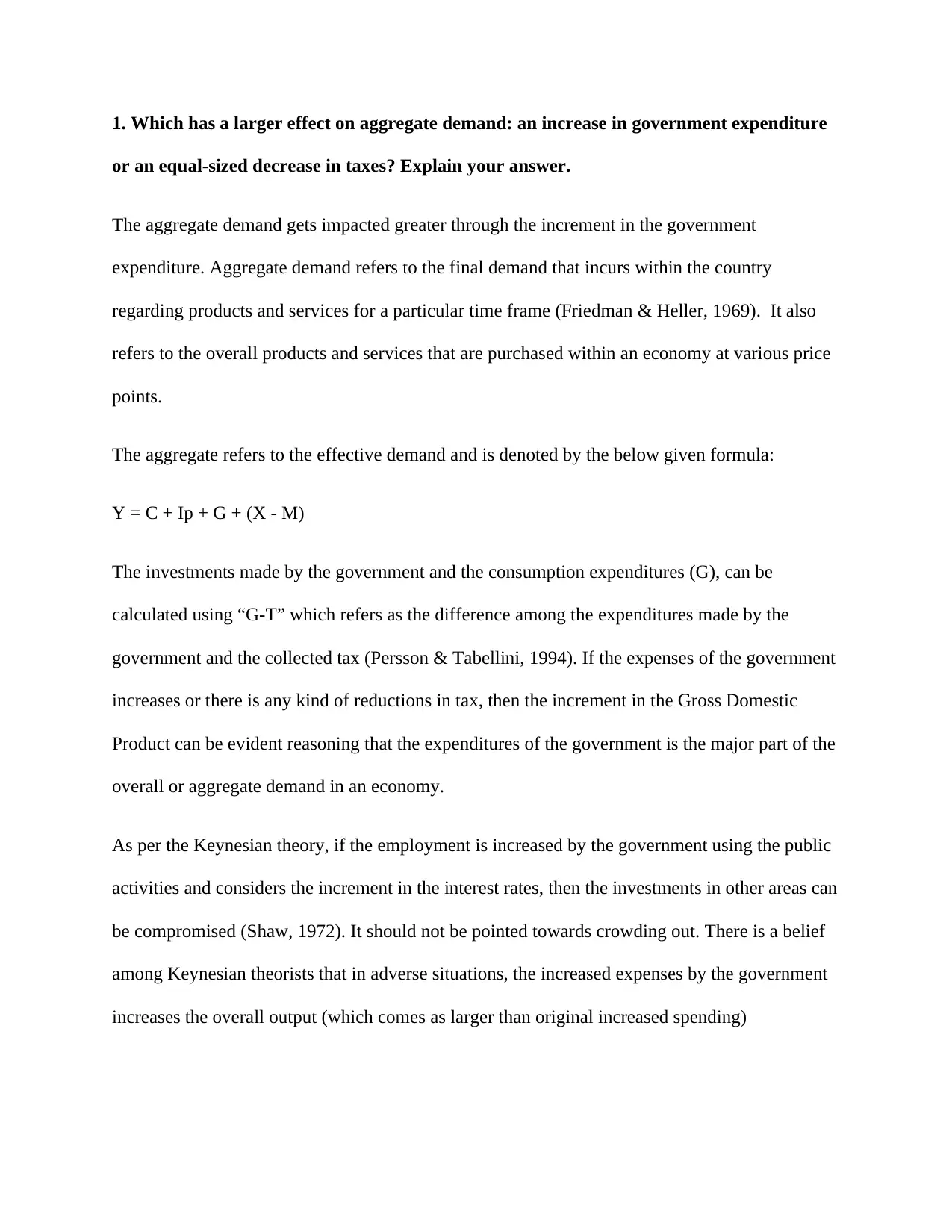
1. Which has a larger effect on aggregate demand: an increase in government expenditure
or an equal-sized decrease in taxes? Explain your answer.
The aggregate demand gets impacted greater through the increment in the government
expenditure. Aggregate demand refers to the final demand that incurs within the country
regarding products and services for a particular time frame (Friedman & Heller, 1969). It also
refers to the overall products and services that are purchased within an economy at various price
points.
The aggregate refers to the effective demand and is denoted by the below given formula:
Y = C + Ip + G + (X - M)
The investments made by the government and the consumption expenditures (G), can be
calculated using “G-T” which refers as the difference among the expenditures made by the
government and the collected tax (Persson & Tabellini, 1994). If the expenses of the government
increases or there is any kind of reductions in tax, then the increment in the Gross Domestic
Product can be evident reasoning that the expenditures of the government is the major part of the
overall or aggregate demand in an economy.
As per the Keynesian theory, if the employment is increased by the government using the public
activities and considers the increment in the interest rates, then the investments in other areas can
be compromised (Shaw, 1972). It should not be pointed towards crowding out. There is a belief
among Keynesian theorists that in adverse situations, the increased expenses by the government
increases the overall output (which comes as larger than original increased spending)
or an equal-sized decrease in taxes? Explain your answer.
The aggregate demand gets impacted greater through the increment in the government
expenditure. Aggregate demand refers to the final demand that incurs within the country
regarding products and services for a particular time frame (Friedman & Heller, 1969). It also
refers to the overall products and services that are purchased within an economy at various price
points.
The aggregate refers to the effective demand and is denoted by the below given formula:
Y = C + Ip + G + (X - M)
The investments made by the government and the consumption expenditures (G), can be
calculated using “G-T” which refers as the difference among the expenditures made by the
government and the collected tax (Persson & Tabellini, 1994). If the expenses of the government
increases or there is any kind of reductions in tax, then the increment in the Gross Domestic
Product can be evident reasoning that the expenditures of the government is the major part of the
overall or aggregate demand in an economy.
As per the Keynesian theory, if the employment is increased by the government using the public
activities and considers the increment in the interest rates, then the investments in other areas can
be compromised (Shaw, 1972). It should not be pointed towards crowding out. There is a belief
among Keynesian theorists that in adverse situations, the increased expenses by the government
increases the overall output (which comes as larger than original increased spending)
Paraphrase This Document
Need a fresh take? Get an instant paraphrase of this document with our AI Paraphraser
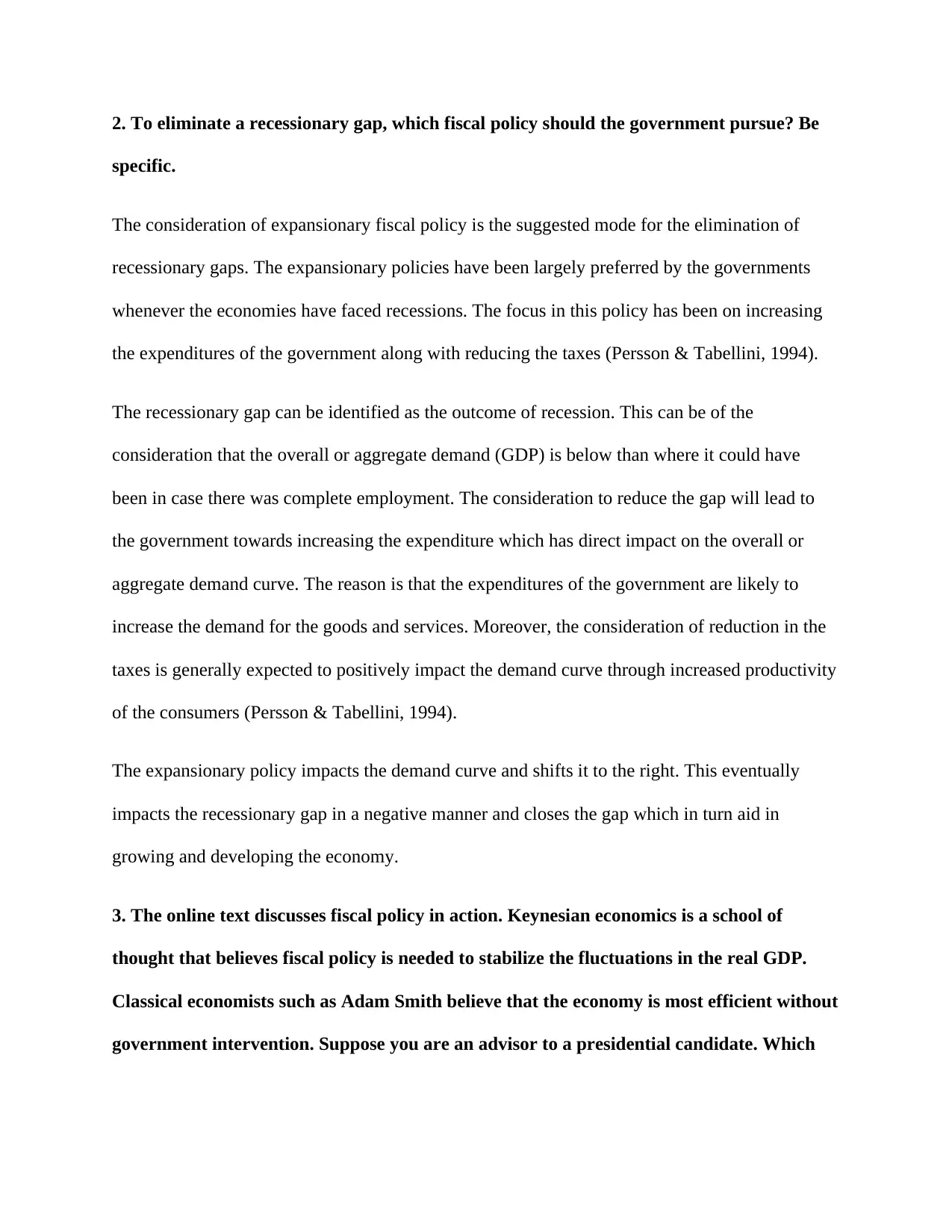
2. To eliminate a recessionary gap, which fiscal policy should the government pursue? Be
specific.
The consideration of expansionary fiscal policy is the suggested mode for the elimination of
recessionary gaps. The expansionary policies have been largely preferred by the governments
whenever the economies have faced recessions. The focus in this policy has been on increasing
the expenditures of the government along with reducing the taxes (Persson & Tabellini, 1994).
The recessionary gap can be identified as the outcome of recession. This can be of the
consideration that the overall or aggregate demand (GDP) is below than where it could have
been in case there was complete employment. The consideration to reduce the gap will lead to
the government towards increasing the expenditure which has direct impact on the overall or
aggregate demand curve. The reason is that the expenditures of the government are likely to
increase the demand for the goods and services. Moreover, the consideration of reduction in the
taxes is generally expected to positively impact the demand curve through increased productivity
of the consumers (Persson & Tabellini, 1994).
The expansionary policy impacts the demand curve and shifts it to the right. This eventually
impacts the recessionary gap in a negative manner and closes the gap which in turn aid in
growing and developing the economy.
3. The online text discusses fiscal policy in action. Keynesian economics is a school of
thought that believes fiscal policy is needed to stabilize the fluctuations in the real GDP.
Classical economists such as Adam Smith believe that the economy is most efficient without
government intervention. Suppose you are an advisor to a presidential candidate. Which
specific.
The consideration of expansionary fiscal policy is the suggested mode for the elimination of
recessionary gaps. The expansionary policies have been largely preferred by the governments
whenever the economies have faced recessions. The focus in this policy has been on increasing
the expenditures of the government along with reducing the taxes (Persson & Tabellini, 1994).
The recessionary gap can be identified as the outcome of recession. This can be of the
consideration that the overall or aggregate demand (GDP) is below than where it could have
been in case there was complete employment. The consideration to reduce the gap will lead to
the government towards increasing the expenditure which has direct impact on the overall or
aggregate demand curve. The reason is that the expenditures of the government are likely to
increase the demand for the goods and services. Moreover, the consideration of reduction in the
taxes is generally expected to positively impact the demand curve through increased productivity
of the consumers (Persson & Tabellini, 1994).
The expansionary policy impacts the demand curve and shifts it to the right. This eventually
impacts the recessionary gap in a negative manner and closes the gap which in turn aid in
growing and developing the economy.
3. The online text discusses fiscal policy in action. Keynesian economics is a school of
thought that believes fiscal policy is needed to stabilize the fluctuations in the real GDP.
Classical economists such as Adam Smith believe that the economy is most efficient without
government intervention. Suppose you are an advisor to a presidential candidate. Which
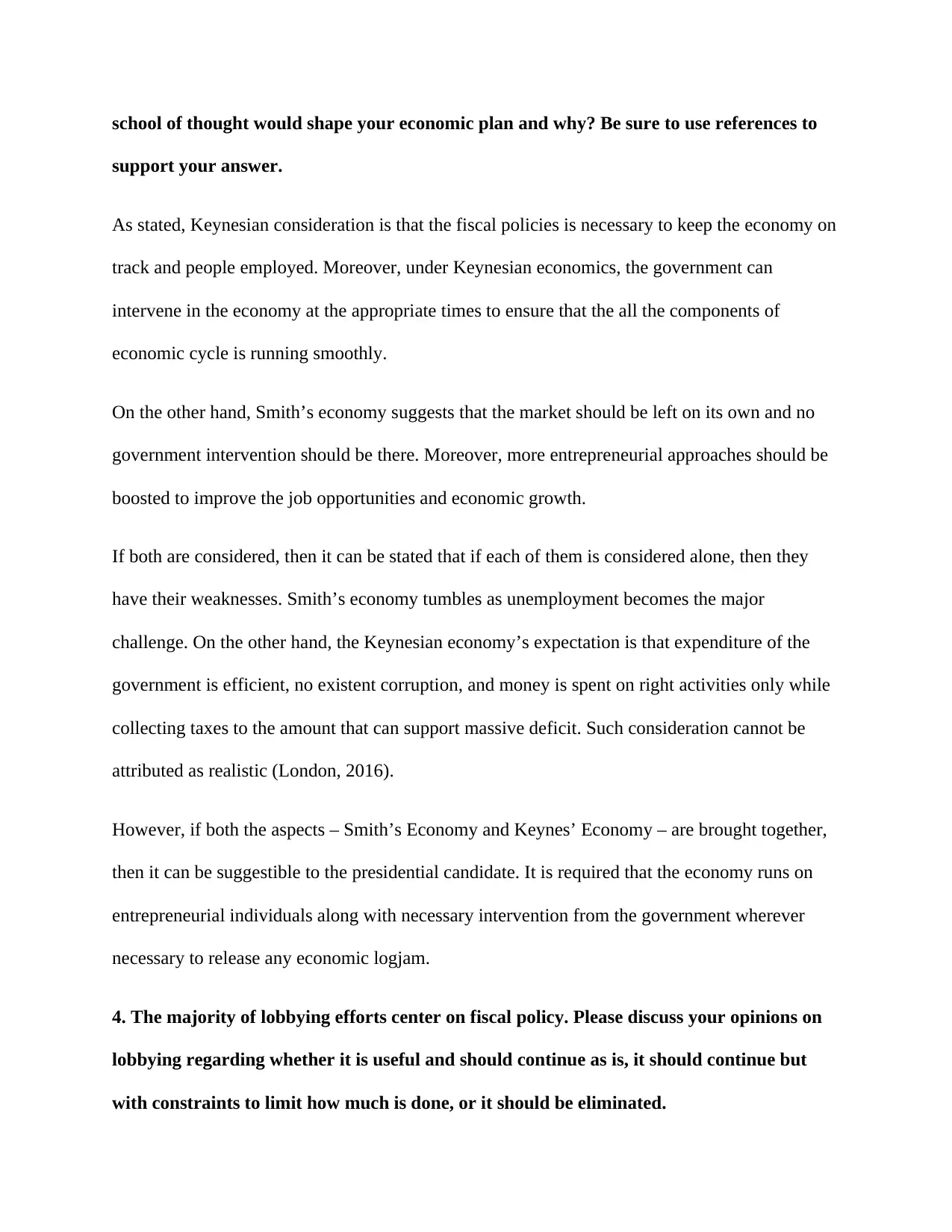
school of thought would shape your economic plan and why? Be sure to use references to
support your answer.
As stated, Keynesian consideration is that the fiscal policies is necessary to keep the economy on
track and people employed. Moreover, under Keynesian economics, the government can
intervene in the economy at the appropriate times to ensure that the all the components of
economic cycle is running smoothly.
On the other hand, Smith’s economy suggests that the market should be left on its own and no
government intervention should be there. Moreover, more entrepreneurial approaches should be
boosted to improve the job opportunities and economic growth.
If both are considered, then it can be stated that if each of them is considered alone, then they
have their weaknesses. Smith’s economy tumbles as unemployment becomes the major
challenge. On the other hand, the Keynesian economy’s expectation is that expenditure of the
government is efficient, no existent corruption, and money is spent on right activities only while
collecting taxes to the amount that can support massive deficit. Such consideration cannot be
attributed as realistic (London, 2016).
However, if both the aspects – Smith’s Economy and Keynes’ Economy – are brought together,
then it can be suggestible to the presidential candidate. It is required that the economy runs on
entrepreneurial individuals along with necessary intervention from the government wherever
necessary to release any economic logjam.
4. The majority of lobbying efforts center on fiscal policy. Please discuss your opinions on
lobbying regarding whether it is useful and should continue as is, it should continue but
with constraints to limit how much is done, or it should be eliminated.
support your answer.
As stated, Keynesian consideration is that the fiscal policies is necessary to keep the economy on
track and people employed. Moreover, under Keynesian economics, the government can
intervene in the economy at the appropriate times to ensure that the all the components of
economic cycle is running smoothly.
On the other hand, Smith’s economy suggests that the market should be left on its own and no
government intervention should be there. Moreover, more entrepreneurial approaches should be
boosted to improve the job opportunities and economic growth.
If both are considered, then it can be stated that if each of them is considered alone, then they
have their weaknesses. Smith’s economy tumbles as unemployment becomes the major
challenge. On the other hand, the Keynesian economy’s expectation is that expenditure of the
government is efficient, no existent corruption, and money is spent on right activities only while
collecting taxes to the amount that can support massive deficit. Such consideration cannot be
attributed as realistic (London, 2016).
However, if both the aspects – Smith’s Economy and Keynes’ Economy – are brought together,
then it can be suggestible to the presidential candidate. It is required that the economy runs on
entrepreneurial individuals along with necessary intervention from the government wherever
necessary to release any economic logjam.
4. The majority of lobbying efforts center on fiscal policy. Please discuss your opinions on
lobbying regarding whether it is useful and should continue as is, it should continue but
with constraints to limit how much is done, or it should be eliminated.
⊘ This is a preview!⊘
Do you want full access?
Subscribe today to unlock all pages.

Trusted by 1+ million students worldwide
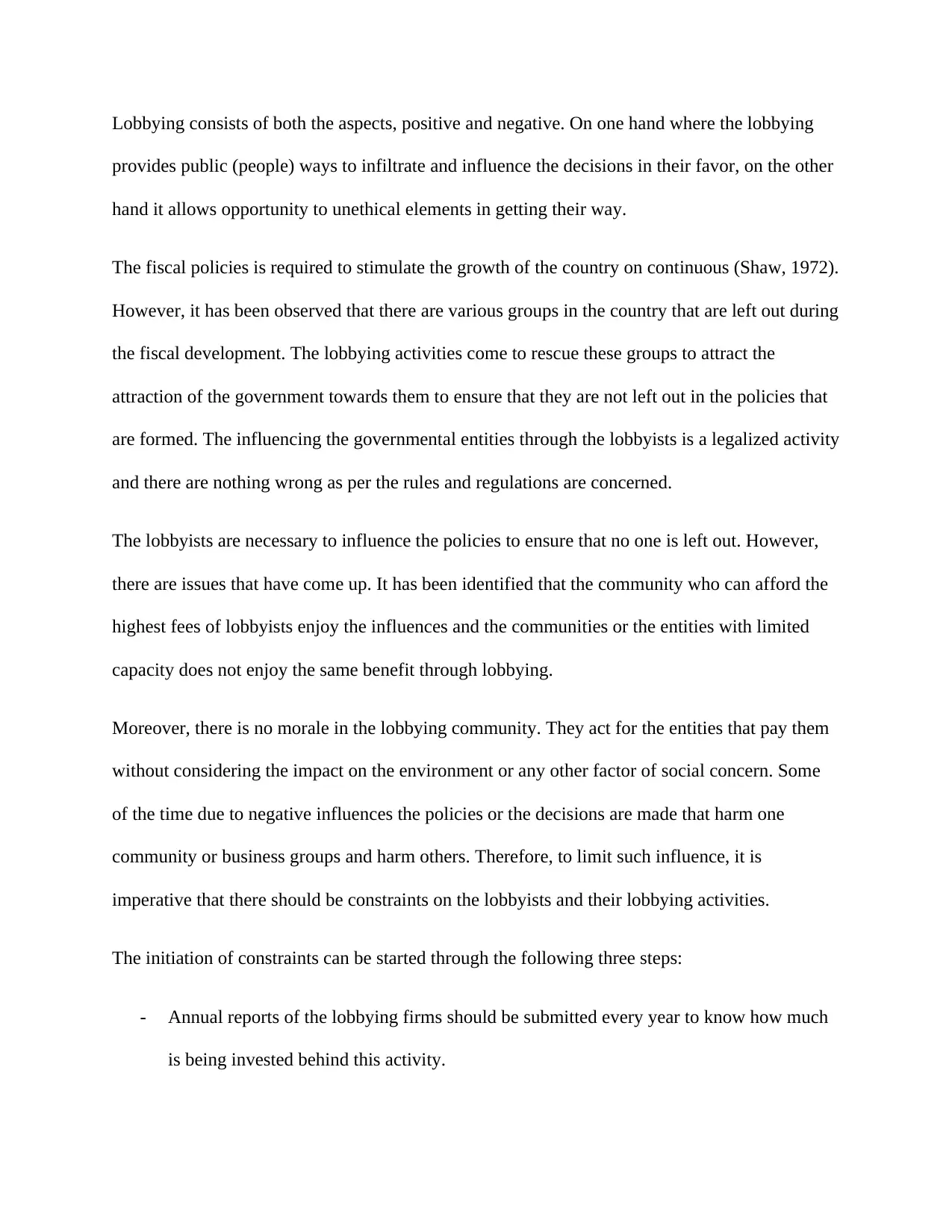
Lobbying consists of both the aspects, positive and negative. On one hand where the lobbying
provides public (people) ways to infiltrate and influence the decisions in their favor, on the other
hand it allows opportunity to unethical elements in getting their way.
The fiscal policies is required to stimulate the growth of the country on continuous (Shaw, 1972).
However, it has been observed that there are various groups in the country that are left out during
the fiscal development. The lobbying activities come to rescue these groups to attract the
attraction of the government towards them to ensure that they are not left out in the policies that
are formed. The influencing the governmental entities through the lobbyists is a legalized activity
and there are nothing wrong as per the rules and regulations are concerned.
The lobbyists are necessary to influence the policies to ensure that no one is left out. However,
there are issues that have come up. It has been identified that the community who can afford the
highest fees of lobbyists enjoy the influences and the communities or the entities with limited
capacity does not enjoy the same benefit through lobbying.
Moreover, there is no morale in the lobbying community. They act for the entities that pay them
without considering the impact on the environment or any other factor of social concern. Some
of the time due to negative influences the policies or the decisions are made that harm one
community or business groups and harm others. Therefore, to limit such influence, it is
imperative that there should be constraints on the lobbyists and their lobbying activities.
The initiation of constraints can be started through the following three steps:
- Annual reports of the lobbying firms should be submitted every year to know how much
is being invested behind this activity.
provides public (people) ways to infiltrate and influence the decisions in their favor, on the other
hand it allows opportunity to unethical elements in getting their way.
The fiscal policies is required to stimulate the growth of the country on continuous (Shaw, 1972).
However, it has been observed that there are various groups in the country that are left out during
the fiscal development. The lobbying activities come to rescue these groups to attract the
attraction of the government towards them to ensure that they are not left out in the policies that
are formed. The influencing the governmental entities through the lobbyists is a legalized activity
and there are nothing wrong as per the rules and regulations are concerned.
The lobbyists are necessary to influence the policies to ensure that no one is left out. However,
there are issues that have come up. It has been identified that the community who can afford the
highest fees of lobbyists enjoy the influences and the communities or the entities with limited
capacity does not enjoy the same benefit through lobbying.
Moreover, there is no morale in the lobbying community. They act for the entities that pay them
without considering the impact on the environment or any other factor of social concern. Some
of the time due to negative influences the policies or the decisions are made that harm one
community or business groups and harm others. Therefore, to limit such influence, it is
imperative that there should be constraints on the lobbyists and their lobbying activities.
The initiation of constraints can be started through the following three steps:
- Annual reports of the lobbying firms should be submitted every year to know how much
is being invested behind this activity.
Paraphrase This Document
Need a fresh take? Get an instant paraphrase of this document with our AI Paraphraser
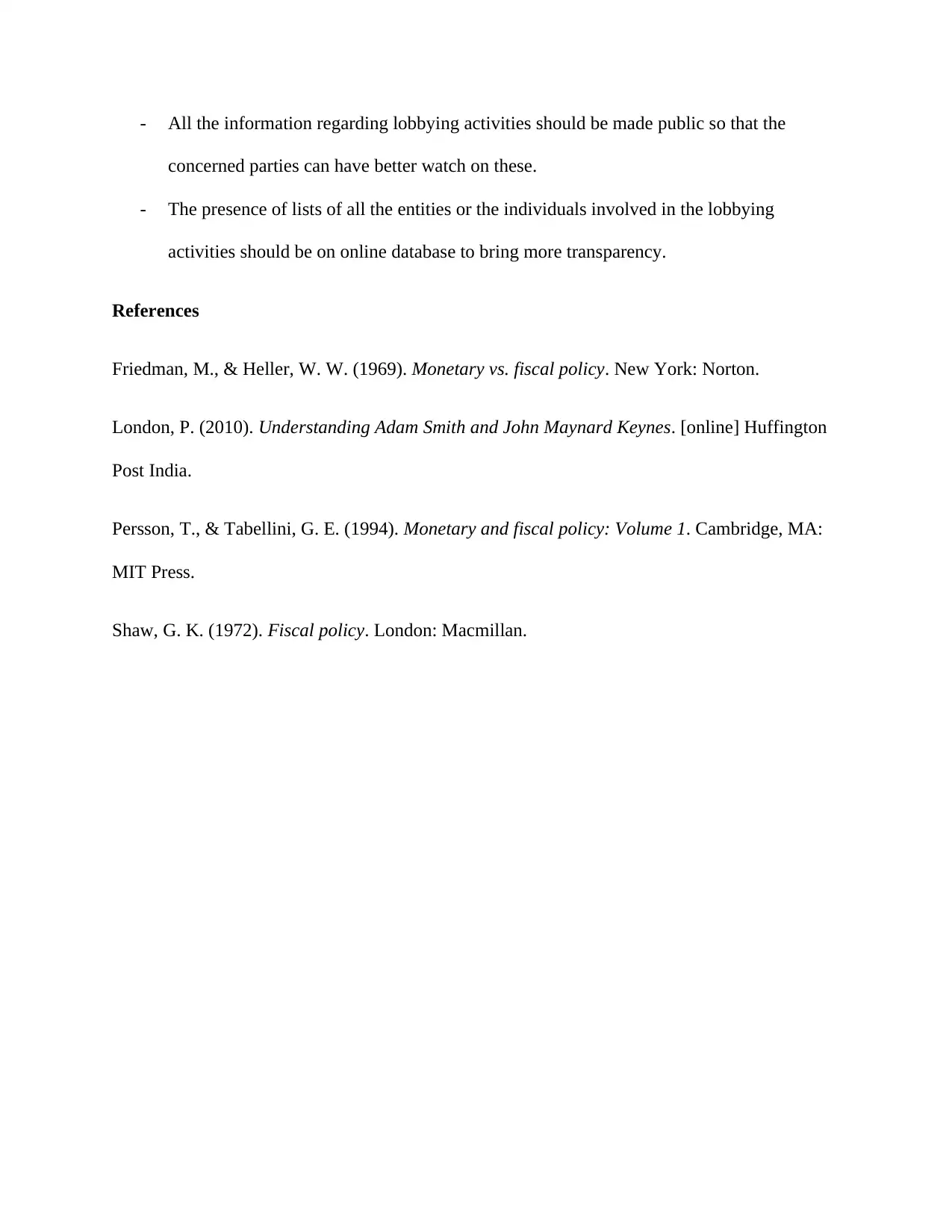
- All the information regarding lobbying activities should be made public so that the
concerned parties can have better watch on these.
- The presence of lists of all the entities or the individuals involved in the lobbying
activities should be on online database to bring more transparency.
References
Friedman, M., & Heller, W. W. (1969). Monetary vs. fiscal policy. New York: Norton.
London, P. (2010). Understanding Adam Smith and John Maynard Keynes. [online] Huffington
Post India.
Persson, T., & Tabellini, G. E. (1994). Monetary and fiscal policy: Volume 1. Cambridge, MA:
MIT Press.
Shaw, G. K. (1972). Fiscal policy. London: Macmillan.
concerned parties can have better watch on these.
- The presence of lists of all the entities or the individuals involved in the lobbying
activities should be on online database to bring more transparency.
References
Friedman, M., & Heller, W. W. (1969). Monetary vs. fiscal policy. New York: Norton.
London, P. (2010). Understanding Adam Smith and John Maynard Keynes. [online] Huffington
Post India.
Persson, T., & Tabellini, G. E. (1994). Monetary and fiscal policy: Volume 1. Cambridge, MA:
MIT Press.
Shaw, G. K. (1972). Fiscal policy. London: Macmillan.
1 out of 5
Related Documents
Your All-in-One AI-Powered Toolkit for Academic Success.
+13062052269
info@desklib.com
Available 24*7 on WhatsApp / Email
![[object Object]](/_next/static/media/star-bottom.7253800d.svg)
Unlock your academic potential
Copyright © 2020–2025 A2Z Services. All Rights Reserved. Developed and managed by ZUCOL.





